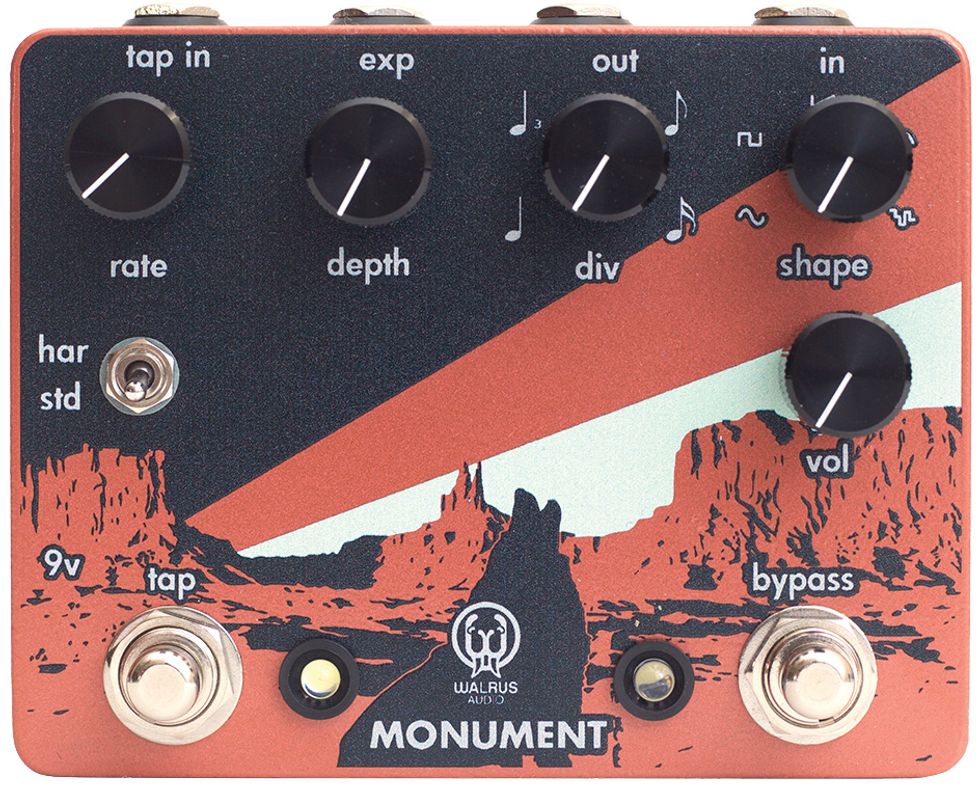Walrus Audio’s Monument is a multi-faceted tremolo pedal with authentic-sounding Fender-style tones and a raft of modern updates. Its marquee feature is the ability to provide both standard and harmonic tremolo types.
Ways to Wiggle
Trem terminology can be tricky, so first, a bit of clarification. (Skip the next two paragraphs, Fender amp experts.) Vintage Fender amps have four flavors of tremolo. The best known is the photocell-driven “opto” trem found in many blackface and silverface models, and Monument has that sound covered. Earlier Fender amps employed “bias” tremolo, wavering the voltage to the power tubes, as on some Princetons and Vibroverbs, or at the preamp tubes, as on Vibro Champs and some Tremoluxes.
for unconventional pulsations.
The fourth modulation type—so-called harmonic tremolo—is a pulse of a different color. The effect appeared briefly in various early-’60s brownface and blond models. It divides your signal into two frequency bands, each modulated separately and offset by 180 degrees.
The phase cancellations produced by this dual modulation yield a swirly, “chewy” sound a bit like a phase shifter at a minimum-feedback setting. Fender soon abandoned this complex circuit (it required three preamp tubes!) in favor of the less costly opto scheme.
Ratings
Pros:
Vintage-approved opto and harmonic trem tones. Multiple waveforms. Tap tempo. Realtime control option. Quality build. Fair price for an ambitious made-in-USA pedal.
Cons:
No stereo output.
Tones:
Ease of Use:
Build/Design:
Value:
Street:
$249
Walrus Audio Monument
walrusaudio.com
Monumental Modulation
The Monument lets you flip between simulated opto and harmonic tremolo via a top-panel toggle (labeled “har/std”). Both sounds are detailed, sensual, and convincingly amp-like. Harmonic mode isn’t as overtly phasey-sounding as it is on some current harmonic trem pedals, but it’s a lovely, immersive sound that I’d be stoked to use on a session. You can hear both modes at the beginning of my audio clip, where I play a phrase twice—first in standard mode and then in harmonic.
Monument’s modern updates are as appealing as its core tones. Besides the expected rate and depth controls, there’s a dedicated tap-tempo switch with a flashing LED to indicate the modulation rate. A jack lets you connect an external tap-tempo switch (not included), which can be handy if Monument occupies a hard-to-reach pedalboard position. You can choose from four waveforms: smooth sounding sine and triangle waves, a sharp and choppy square wave, and a chaotic random mode. Players who have trouble tapping in rhythms other than on-the-beat quarter notes will appreciate Monument’s time-division knob.
Peaks and Valleys
You can also connect an expression pedal (not included) and control the modulation speed by foot—a potentially expressive technique. As shipped, the range of Monument’s rate knob is unusually wide, with an ultra-fast flicker at the highest setting. That means small pedal moves can trigger big rate changes, and it can be tricky to hit specific targets.
A final simple but important feature is a dedicated volume knob. Since tremolo effects cut rather than boost, it’s nice to be able to raise the level to compensate for this loss of energy. (I find that a boost of approximately 3 dB usually provides a nice “gushing” quality.) Monument occupies a standard B-sized enclosure decorated with a cool illustration of a Monument Valley coyote. The pedal uses soft-touch relay switches for bypass and tap tempo. It runs on standard 9V power and has no battery compartment.
The Verdict
Monument augments its stellar vintage-style trem tones with modern functionality and multiple modulating waveforms for unconventional pulsations. The lack of stereo outputs may be an issue for some guitarists—especially ones who like to position tremolo downstream from stereo delay and reverb effects. But if that’s not a concern, you’re likely to love Monument’s world-class wobble.












![Rig Rundown: John 5 [2026]](https://www.premierguitar.com/media-library/youtube.jpg?id=62681883&width=1245&height=700&quality=70&coordinates=0%2C45%2C0%2C45)




![Rig Rundown: Russian Circles’ Mike Sullivan [2025]](https://www.premierguitar.com/media-library/youtube.jpg?id=62303631&width=1245&height=700&quality=70&coordinates=0%2C0%2C0%2C0)








